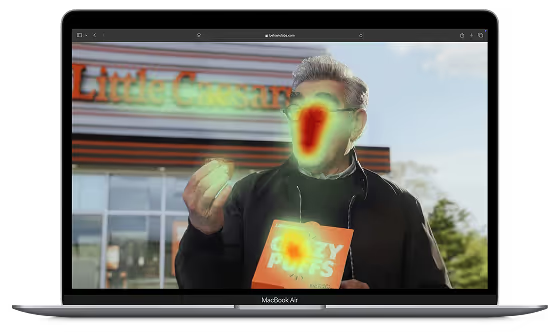Testing your ads before you launch them ensures they are effective and connect with your target audience.
This comprehensive guide explores the fundamentals of ad testing, highlighting its benefits, key metrics, and best practices to help you craft impactful and successful ad campaigns.
There’s almost no limit to what you can test when it comes to the ad creation process. You can test:
- Early Ideas
- Concepts
- Storyboards
- Key Visuals
- Banners
- Posters
- Billboards
- Products
- Brand Assets
- Videos
- TV Commercials
… and much more!
We’ll show you a couple of examples from real-life ads, so you get a better idea of what it actually looks like.
Sounds good? Let’s get straight into it.
.avif)
What is ad testing?
Ad testing is a systematic process marketers use to evaluate and optimize their advertisements before (or after) a full-scale launch.
This involves testing various ad formats—such as storyboards, concepts, videos, and TV commercials—across different stages of development to measure their effectiveness and resonance with the target audience.
The goal is to refine the creative elements to ensure they deliver the intended message, enhance engagement, and improve overall campaign performance, ultimately maximizing return on investment (ROI).
But don’t just take our word for it – this has been proved by scientists time and time again.
What makes an ad effective?
Research has shown that effective ad creatives excel in three different things:
- branding
- need
- emotion
For maximum effectiveness, all three components must be done well.
Branding in ads
For a campaign to succeed, it must have strong, and consistent branding, ideally through brand symbols and assets.
This means that the audience always recognizes which brand is being advertised.
Great brands can make themselves known even without using a logo. Look no further than the color palette of a particular restaurant chain as seen below.
Long story, short – your ad may be a hilarious short film but without clear and distinctive branding, it won’t be an effective campaign.

Need in ads
A great ad has to address the customer’s need within the campaign.
Simply put: a campaign succeeds and attracts new customers when it creates a clear connection between the customer’s need and the brand.
The audience must therefore have an understanding of the ad’s message.
Emotion in ads
The emotional response is heavily emphasized in modern communication. Emotions alone, however, are insufficient.
Emotion acts as an amplifier that helps our brains retain campaign information.
The more fun your audience is having while watching your TV commercial, the more likely they are to remember what it was about.
Behavio is unique in measuring all three metrics—branding, need, and emotion—throughout video campaigns, providing clear insights into strengths and areas for improvement.
What are some ad testing methods?
Surveys
Surveys are a quantitative method used to gather large-scale data on audience reactions to ads.
Participants answer structured questions about their perceptions, preferences, and recall, providing measurable insights into ad effectiveness.
The drawback is the limited depth of responses, potentially missing nuanced emotional reactions.
Focus groups
Focus groups are a qualitative method involving small, diverse groups of participants who discuss their reactions to ads in a moderated setting. This approach provides in-depth insights into emotional responses, motivations, and perceptions.
The small sample size, however, may not be representative, and moderation can influence responses.

Implicit testing
Implicit testing measures subconscious reactions to ads using techniques such as reaction time tests and eye-tracking. This method uncovers automatic, unconscious responses, providing a deeper understanding of how ads influence audience emotions and attitudes.
The disadvantage is that it requires specialized tools and expertise, making it complex and costly.
A/B testing
A/B testing compares two versions of an ad to determine which one performs better. By randomly showing different versions to segments of the target audience, marketers can identify which elements—such as visuals, copy, or calls to action—resonate most effectively.
The challenge is that it is limited to two variations at a time, necessitating a large sample size for accuracy.
Ad testing software
Ad testing software like Behavio can offer a more in-depth and precise look than other, more traditional methods.
Drawing on recent marketing science, Behavio analyzes the three key components of effective advertising (see above).
Behavio also doesn’t simply ask the respondents, it tasks them. This allows for more accurate results that mirror people’s actual buying behavior.
Ad testing can be done before a campaign launch (pre-test) or after (post-test).

How does Behavio test ads?
Behavio tests ads using a combination of advanced behavioral science methods, including randomized control trials (RCTs), implicit association tests, and emotional diagnostics.
Each ad is tested with a robust sample of over 500 respondents to provide precise and valuable insights.
The process involves uploading the creative, defining the category, and receiving detailed feedback within five days, allowing marketers to compare variants and choose the best-performing ad.
But enough theory. Here’s a couple of examples of how that looks in real-life testing:
Amazon: ad test results
People love this campaign! But weak branding hinders the impact.

Febreze: ad test results
The audience loves this brand and enjoys the ad. Additionally, the video does a great job at getting its main point across!

Verizon: ad test results
The ad has a great vibe, but the free phone offer steals the spotlight from the brand.

Bottom line: is ad testing worth it?
The short answer – absolutely. There’s only so much guessing you can do.
Ad testing has helped many marketers pinpoint parts of their ads that didn’t work well and improve them or change them entirely.
McDonald’s is such an example.
A quick test of their creative showed that the voice-over the team has decided upon is less than desirable to their target audience. Fortunately, because they had tested their video before its launch, the team had time to change the voice-over to one that resonated with the viewers. Indeed – the final product had a much bigger impact.
Ad testing proves essential, especially for smaller brands.
It’s even more crucial for start-ups, rising stars, and medium-sized brands to nail their ads the first time since their budgets tend to be much smaller. There’s simply no room for mistakes. Ad testing eliminates them.
With solutions like Behavio, which bring actionable improvements at a great price, ad testing should be a no-brainer for every marketer who wants their campaign to succeed.
Curious to find out more about ad testing, or want to start testing yourself? We’ll be happy to show you around our platform - request a call!











.avif)








